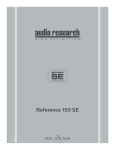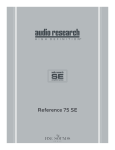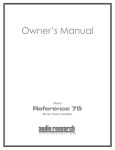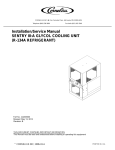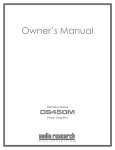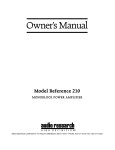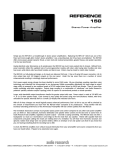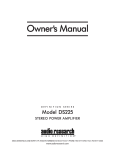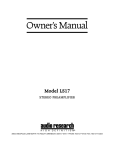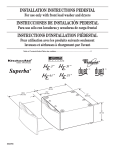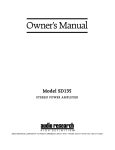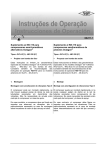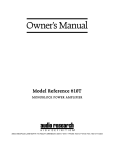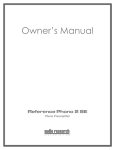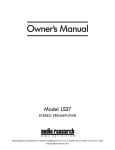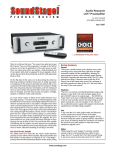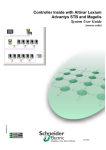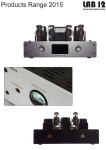Download Owner`s Manual - Audio Emotion
Transcript
Owner’s Manual Model Reference 150 Stereo Power Amplifier Contents Model Reference 150 Stereo Amplifier Illustrations 3 Preface 4 Packaging 4 Accessories 4 Warnings 4 Vacuum Tubes and Preparation for Use 5 Panel Controls 5 Use of Controls 5 Installation 5 Connections 6 – 7 Remote Turn-on Connections 7 Operating Procedure 7 Output Tube Bias Adjustment 8 Cooling Fan Speed Adjustment 8 Hour Meter 8 Servicing 8 Cleaning 9 Disposal and Recycling Guidelines 9 Limited Warranty 9 Specifications 10 2 3 Preface Please take time to carefully read and understand the following instructions before you install or attempt to operate this equipment. Becoming familiar with the product and its correct operating procedures will help assure you of maximum musical enjoyment and reliable operation. The effort you invest now will be well rewarded in the years ahead. Packaging Save all packaging accompanying this product. You have purchased a precision electronic instrument, and it should be properly cartoned any time shipment becomes necessary. It is very possible that this unit could be damaged during shipment if repackaged in cartoning other than that designed for it. The original packaging materials help protect your investment from unnecessary damage, delay and added expense whenever shipment of this unit is required. Accessories 1 – Phillips head screwdriver for cover removal 1 – Plastic screwdriver for bias adjustments User replaceable spare line fuses include: 1 – 7 Amp MDQ slo-blo with 120V units or 100V units 1 – T4A 250V slo-blo with 220V/240V units Warnings 1. Do not touch hot tubes. Keep away from children. 2. To prevent fire or shock hazard, do not expose your Reference 150 to rain or moisture. 3. This unit contains voltages which can cause serious injury or death. Do not operate with covers removed. Refer servicing to your authorized Audio Research dealer or other qualified personnel. 4 4. The 12-gauge, 3-conductor power cord on your Reference 150 is equipped with a standard 3-prong grounding plug. If used normally, it will provide a safe earth ground connection of the chassis. Refer to the section on ‘AC Power Connections’ for detailed information. 5. For continued protection against fire hazard, replace fuses only with the same type and rating of fuses specified. Warning Read Owner’s Manual before installing or operating this product! Do not attempt to install or remove any vacuum tubes unless this unit is turned off and disconnected from the A.C. power outlet. Unit should be connected to the A.C. outlet and turned on only after all vacuum tubes have been installed and appropriate panels have been replaced and fastened. See owner’s manual for installation instructions. Before replacing vacuum tubes, turn off unit, disconnect from A.C. outlet and allow installed tubes to cool before attempting to remove them. Hot tubes may cause burns or other injury if not allowed to cool before removal. When removing or installing tubes, do not touch tube socket contacts or other components as the circuit may retain sufficient levels of voltage and current to cause injury or death. Contact your dealer or Audio Research Customer Service (763.577.9700) if you have any questions about installing or replacing vacuum tubes in this unit. DO NOT ATTEMPT TO OPERATE THIS EQUIPMENT BEFORE INSTALLING THE NUMBERED VACUUM TUBES IN THEIR RESPECTIVE SOCKETS (SEE NEXT PAGE FOR CHART). recommend leaving your Reference 150 ‘on’ 24 hours a day as is the custom of some audiophiles to achieve maximum sonic performance on demand. While this is often recommended for solid-state equipment, Audio Research does not recommend this procedure for vacuum tube power amplifiers. (2,000 hours of tube life will elapse in 84 days!) Installation Vacuum Tubes and Preparation for Use Your Reference 150 amplifier is shipped with the vacuum tubes packed in foam blocks. These must be unpacked and installed before you attempt to operate the amplifier. Included are four matched pair of KT120 output tubes, and four 6H30 dual triodes used in the input stage. Proceed according to the following instructions. Carefully remove each vacuum tube from its protective foam and match its location ‘V’ number (written on the base of the tube) to the ‘V’ number printed next to each socket. Firmly seat each tube in its matching socket, taking care to ‘key’ the tube pins to the socket holes. Retain the foam blocks with other packing materials for possible future use. Refasten top cover on amplifier. Panel Controls The front panel has: 1 Power line On-Off switch 1-Power ‘On’ LED (Green) indicator POWER-ON SWITCH: Initiates/terminates AC line power to the amplifier. Function indicated by green LED above switch. Note: Audio Research does not To insure normal component life and safe operation this unit must be operated only in an upright position. Adequate airflow and proper cooling can occur only if there is no restriction above and behind the unit and on either side. Be sure that airflow to the 12V D. C. cooling fans located on the rear panel is not blocked. The special non-marring elastomer feet provide adequate spacing and stability only on a smooth, hard surface. For upright stability, never operate the unit while it is sitting on a soft surface such as a thick rug or carpet. Due to its weight, this amplifier must be supported on a surface specifically rated for such a load. Check with the manufacturer of your support system to be sure it is rated to handle this weight. If the unit is to be operated in an enclosure such as an equipment rack, make certain that adequate airflow above and to each side of the unit is provided. The ‘ambient’ operating temperature should never exceed 120 F or 49 C. Improper installation will cause premature tube failure and will affect your warranty, as well as the service life of the unit. It is normal for a vacuum tube power amplifier to run quite warm, and if used for prolonged periods, hot to the touch. All components within are, however, operated at safe, conservative levels and will not be improperly affected thereby, providing the requirements outlined above are adhered to. 5 Connections Input Connector: The Reference 150 uses a fully balanced circuit topology and has a pair of balanced XLR input connectors on the rear panel. It therefore requires a balanced preamplifier output, as provided by most Audio Research preamplifiers. Connect your preamplifier's output to the Reference 150 before turning on the amplifier. Output Connectors: Proprietary, heavyduty output terminals are provided on the rear panel for 4, 8,or 16-ohm speaker impedance loads. Using high-quality speaker cables, securely fasten the (-) speaker lead to the appropriate (-) terminal, then the (+) lead to the matching (+) terminal. Following your speaker manufacturer's impedance specification. The Reference 150 puts out the same amount of power whether the 4, 8 or 16-ohm terminals are used. Important: Use the best available speaker wires and interconnects. Audio Research cannot emphasize this enough. As better components and systems are developed, it becomes increasingly important to avoid the limitations of inferior system interconnections. It is important sonically that your entire system be connected so that the audio signal arriving at the speakers has correct, or ‘absolute’ polarity (i.e., noninverted). Connect the black or ‘–‘ speaker terminal to the wire that connects to the ‘0’ terminal on the Reference 150. Connect the red or ‘+’ speaker terminal to the wire that connects to the ‘4’ or ‘8’ terminal on the Reference 150 and tighten the speaker terminals securely to ensure best sonic results. Matching: It is important to use as close as possible an impedance match between the amplifier and speaker for optimum transfer of power to the speaker with minimum distortion. In the case of speaker systems with significant variations in impedance throughout the frequency spectrum, such as most 6 electrostatic types, determine the best impedance match empirically for best overall sonic results. Connect the Reference 150 input to the preamplifier or electronic crossover, using only the highest grade of audio interconnect cables. To avoid sonic degradation use the shortest practical length of cables. A.C. Power Connections: It is important that the Reference 150 be connected via its supplied 20 amp IEC 12-gauge power cord to a secure, dedicated A.C. power receptacle. Never connect to convenience power receptacles on other equipment. Only use the power switch on the front of the Reference 150 for On/Off control of the amplifier, or the 12V start-up trigger for remote installations. The AC power source for the Reference150 amplifier should be capable of supplying 10 amperes for 100 or 120 volt units, or 5 amperes for 220 or 240 volt units. For the very best performance on domestic 100 or 120 volt circuits, the Reference 150 should be connected to its own AC power circuit branch, protected by a 15 amp breaker. The preamplifier and other audio equipment should be connected to a different power circuit and breaker. The Reference 150 should be turned on after the other components of your system. If the Reference 150 is turned on before other components, the amplifier will amplify any extraneous turn-on noises those components might generate, which could potentially damage the loudspeakers. Good operating practice dictates that the amplifier should be turned on last, and turned off first in an audio system. The Reference 150 uses a grounding system that does not require a groundlifter adaptor plug on the A.C. power cord to minimize hum. The power cord supplied with the Reference 150 has a standard grounding plug to provide maximum safety when properly connected to a grounded wall receptacle. If there is any question regarding proper grounding procedures in your installation, seek help from a qualified technician. Caution should be taken before using custom after-market power cords: they must be at least 12gauge and have a standard grounding plug properly installed. These power cords are to be used with caution, at the sole risk of the owner. If electronic crossovers or other AC powered equipment is used with the Reference 150 it may be necessary to use ‘ground lifter’ adapters on the power plugs of that equipment to minimize system hum. Generally, the lowest hum is achieved when the only direct connection between audio common ‘ground’ and true earth ground occurs in the preamplifier, through its grounded power cord. Other equipment in the system should have some form of isolation to prevent ground loops and associated hum. Always place the power on-off switch on the panel of the Reference 150 in the ‘Off’ position before connecting the power line cord to AC power. Remote Turn-On Connections The Reference 150 has a built-in 12VDC remote turn-on/off circuit for operation by a master control system in a home theater or large audio system. Use a 3.5mm (.140") diameter mono mini plug to connect to the +12V IN jack on the rear of the Reference 150. Two identical paralleled jacks are provided to allow chaining connections to control two or more Reference 150s or other equipment. The +12V IN jack should be connected to the +12VDC output of the master control system, using a continuous +12VDC signal at 12mA per Reference 150 for the duration of amplifier on-time. Do not use a momentary or data pulse control signal. The front power rocker switch on the Reference 150 must be off to use the remote turn-on. The front power rocker switch may still be used when the remote turn-on is connected, but the remote will not turn the Reference 150 off if the front power rocker switch is left on. The front power rocker switch will not turn the Reference 150 off if the remote system is on. The +12VDC remote jacks have polarity protection, so they will not operate if a 12VDC signal is accidentally connected, or if the control wires are reversed. The 12V remote relay in the Reference 150 has click suppression to protect circuits in the master control system. Operating Procedure Start-Up 1. Secure input connection between the amplifier and your preamplifier; attach speaker leads to the appropriate output terminals. 2. Attach supplied power cord to rear IEC inlet of amplifier, and plug other end into grounded A.C. power receptacle. 3. Turn on preamp and all other components; mute preamp output. 4. Turn Reference 150 front-panel control from Off to On. Green power LED will light. 5. Unmute preamplifier output, initiate source component signal, and adjust gain as appropriate. Shut-Down: 1. Mute preamplifier output. 2. Turn Reference 150 front-panel control from Operate to Off. 3. Turn off preamplifier and then the associated input source components. Note After the Reference 150 is turned off, wait at least five minutes before turning it on again. 7 Output Tube Bias Adjustment As shipped from the factory, the output ‘bias’ adjustments are set for a nominal 65mA per KT120 tube. Under these idle conditions the tubes are each dissipating approximately 27 watts of their 60 watt rating. This point of operation provides ‘enriched’ Class AB1, and will satisfy the most critical listener. For best results, operate and adjust the Reference150 at 120VAC. Adjustment must be made under zero-signal conditions after at least 15-20 minutes of uninterrupted stabilization time. A digital voltmeter capable of accurate measurements with 0.lmVDC resolution is preferred for accurate adjustment (must have 31/2 digit display). Use the plastic alignment tool provided to make the adjustment. The measurement points are yellow and black banana test jacks next to each output tube. Adjust the ‘bias’ for a voltage reading of 65mVDC (.065 Volt DC) at the blue bias pot for one of each output tube pair as follows, noting the voltage setting of the larger V number tube in each pair is slaved to the adjustment setting of its lower V number companion tube: Adjust V5 for 65mVDC and measure its companion tube V7 to verify a reading of 57 to 73mVDC. Repeat procedure by adjusting and measuring V9 to read 65mVDC and verify V11 reads 5773mVDC; adjust and measure V6 to read 65mVDC and verify V8 reads 5773mVDC, and finally adjust and measure V10 to read 65mVDC and verify that V12 reads 57-73 mVDC. Cooling Fan Speed Adjustment The two D.C. cooling fans located at the rear of the Reference 150 are adjustable in speed. Locate the red colored dipswitch under the top cover at the top near the center of the back panel. For highest fan speed move both white tabs on the red dip switch to the upward position; for medium fan speed move either one of the tabs to the downward 8 position, and for low fan speed move both tabs to the downward position. For maximum cooling and extended tube life, use the highest fan speed possible. Be sure to first turn off and unplug the Reference 150 from its power receptacle before unscrewing the top cover to access the switch. Refasten the top cover before resuming operation. Do not operate the Reference 150 with fans disconnected or if one or both fans should stop running. Hour Meter An LCD hour meter of elapsed tube operating time can be viewed through the top cover near the front, mounted on the right main circuit board. This displays accumulated hours of vacuum tube service life. If the amplifier is unplugged from A.C. supply, total accumulated hours are retained. May be reset by qualified technician. Contact Audio Research Customer Service for more information about reset procedure. Servicing Because of its careful design and exacting standards of manufacture, your Reference 150 amplifier should normally require only minimal service to maintain its high level of performance. Caution: The Reference 150 amplifier contains sufficient levels of voltage and current to be lethal. Do not tamper with a component or part inside the unit. Even with the power turned off, a charge remains in the energy storage capacitors for some time. Refer any needed service to your authorized Audio Research dealer or other qualified technician. Additional questions regarding the operation, maintenance or servicing of your amplifier may be referred to the Customer Service Department of Audio Research Corporation at 763.577.9700 (CST). When ordering a service manual from Audio Research or an authorized dealer, be sure to identify the serial number on your amplifier. Cleaning Limited Warranty To maintain the new appearance of this amplifier, occasionally wipe the front panel and top cover with a soft, damp (not wet) cloth to remove dust. A mild, non-alkaline soap solution may be used to remove fingerprints or similar smudges. Cleaners containing abrasives should not be used as they will damage the anodized finish of the front panel. A small, soft paintbrush is effective in removing dust from bevels, the recessed nameplate and other features of the front panel. Audio Research Corporation products are covered by a 3-Year Limited Warranty or a 90-Day Limited Warranty (vacuum tubes). This Limited Warranty initiates from the date of purchase, and is limited to the original purchaser, or in the case of demonstration equipment, limited to the balance of warranty remaining after original shipment to the retailer or importer. In the United States, the specific terms, conditions and remedies for fulfillment of this Limited Warranty are listed on the warranty card accompanying the product in its shipping carton, or may be obtained from the authorized retailer or from the Audio Research Customer Service Department. Outside the United States, the authorized importing retailer or distributor has accepted the responsibility for warranty of Audio Research products sold by them. The specific terms and remedies for fulfillment of the Limited Warranty may vary from country to country. Warranty service should normally be obtained from the importing retailer or distributor from whom the product was purchased. In the unlikely event that technical service beyond the ability of the importer is required, Audio Research will fulfill the terms and conditions of the Limited Warranty. Such product must be returned at the purchaser's expense to the Audio Research factory, along with a photocopy of the dated purchase receipt for the product, a written description of the problem(s) encountered, and any information necessary for return shipment. The cost of return shipment is the responsibility of the purchaser. Disposal and Recycling Guidelines To dispose of this electronic product, do not place in landfill. In accordance with the European Union Waste Electrical and Electronic Equipment (WEEE) directive effective August 2005, this product may contain regulated materials which upon disposal require special reuse and recycling processing. Please contact your dealer or importing distributor for instructions on proper disposal of this product in your country. Or, contact Audio Research Corporation (763.577.9700) for the name of your importing distributor and how to contact them. Packing and shipping materials may be disposed of in a normal manner. 9 Specifications POWER OUTPUT: 150 watts per channel continuous from20Hz to 20kHz. 1kHz total harmonic distortion typically 0.6% at 150 watts, below 0.03% at 1 watt. Approximate actual power available at ‘clipping’ 160 watts (1kHz). (Note that actual power output is dependent upon both line voltage and ‘condition’ i. e.: if power line has high distortion, maximum power will be affected adversely, although from a listening standpoint this is not very critical.) POWER BANDWIDTH: (-3dB points) 5Hz to 80kHz. FREQUENCY RESPONSE: (-3dB points at 1 watt) 0.5Hz to 120 kHz. INPUT SENSITIVITY: 2.0V RMS BAL for rated output. (24 dB Bal gain into 8 ohms.) INPUT IMPEDANCE: 300K ohms Balanced. OUTPUT POLARITY: Non-inverting. Balanced input pin 2+ (IEC-268). OUTPUT TAPS: 16 ohms, 8 ohms, 4 ohms. OUTPUT REGULATION: Approximately 0.6dB 16 ohm load to open circuit (Damping factor approximately 14). OVERALL NEGATIVE FEEDBACK: 14dB. SLEW RATE: 13 volts/microsecond. RISE TIME: 2.0 microseconds. HUM & NOISE: Less than 0.1mV RMS – 114dB below rated output (IHF weighted, input shorted). POWER SUPPLY ENERGY STORAGE: Approximately 1040 joules. POWER REQUIREMENTS: 105-125VAC 60Hz (210250VAC 50Hz) 730 watts at rated output, 900 watts maximum, 420 watts idle. TUBES REQUIRED: 4 – Matched pair KT120 – Power Output; 4 – 6H30 Driver. DIMENSIONS: 19" (48.3 cm) W x 8.75" (22.2 cm) H x 19.5" (49.5 cm) D. Handles extend 1.5" (3.8 cm) forward. WEIGHT: 75 lbs. (34.2 kg) Net; 90 lbs. (41 kg) Shipping. Specifications subject to change without notice. ©2011 Audio Research Corporation. 3900 Annapolis Lane North Plymouth, MN 55447 1.763.577.9700 www.audioresearch.com 10










